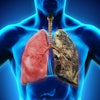
Chest CT computer-aided detection (CAD) software integrated into a radiology report dictation application reduced radiologist reading times by up to 44% over conventional manual interpretations, according to research published online in Academic Radiology.
The study focused on assessing the impact of a commercial chest CT CAD system on radiologist efficiency. The researchers, led by Matthew Brown, PhD, of the University of California, Los Angeles, found that three radiologists were 7% to 44% faster in generating reports with CAD than they were without using CAD.
"Prepopulation of a report with automated nodule and aorta measurements yielded substantial time savings relative to manual measurement and entry," the authors wrote. "It may be that CAD integration and measurement accuracy and acceptance are just as important as sensitivity/specificity in efficiency and adoption."
The researchers speculated that the lack of CAD's integration into radiology reporting workflow -- as well as a proven efficiency benefit -- may be contributing to the technology not being adopted in clinical practice. As a result, they sought to investigate the impact of the Virtual Resident software (RadLogics) when integrated with PowerScribe 360 radiology dictation software (Nuance Communications).
Virtual Resident provides automated detection and measurement of lung nodules, the ascending and descending aorta, and pleural effusion. It then automatically prepopulates radiology report templates with the diameter of the ascending and descending aorta, as well as lung nodule measurements -- longest diameter, perpendicular; slice number; solidity; calcification; and lobe location (Acad Radiol, August 8, 2018).
Two nonthoracic radiologists and one thoracic radiologist read 40 studies from the Lung Image Database Consortium (LIDC) lung nodule database in two ways: without CAD, producing a manually populated report with measurements using electronic calipers, and with CAD after the software prepopulated the report for reader review and editing.
| Radiologist reading times by reading method for Virtual Resident CAD | |||
| Mean reading time without CAD | Mean reading time with CAD | Savings in reading time | |
| Radiologist 1 | 8:49 minutes | 4:57 minutes | 44% |
| Radiologist 2 | 9:22 minutes | 8:45 minutes | 7% |
| Radiologist 3 | 3:08 minutes | 2:31 minutes | 19% |
The readers tended to accept the software's automated measurements, which were found to be within the interreader range of independent manual measurements, according to the researchers.
"Based on the measurement accuracy and reader acceptance it seems that the time savings are due to CAD automation, and we also attempted to minimize memory effects by reversing the reading method order for half of the cases," the authors wrote.
The researchers also noted that the two reading methods led to a similar total number of reported nodules, suggesting that the software produces comparable levels of sensitivity while increasing the efficiency for the type and size of nodules included in the reports.
"However, it is an area requiring further study and our ability to investigate was limited because we do not have nodule coordinates to match markings between readers," the authors wrote.
Study disclosures
RadLogics and the University of California's Tobacco-Related Disease Research Program provided funding for the study.




















